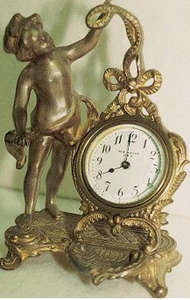In the early 1850s, the New Haven Clock Company was incorporated with $20,000. The president of the company was Hiram Camp, who retained that title for forty years.
The company was formed to produce inexpensive brass movements for the Jerome Manufacturing Company, but the Jerome company went bankrupt and had to sell its assets, including its manufacturing plant. Good fortune arose when the New Haven Clock Company purchased the defunct Jerome Company. From that day in the mid-1850s, until the 1880s, the company experienced great success. In addition to expanding its operations by making completeclocks, it promoted pocket watches and wrist watches.
New Haven soon became one of the largest clock companies in the United States. Among the clocks produced were French clocks; jewelers’ regulators; ebony and mahogany cabinet clocks; wall clocks (including calendar varieties); figure clocks (now called statue clocks); and tall-case hall clocks.
New Haven sales offices were located around the world in such cities as Liverpool, England; and Yokohama, Japan. Through catalogs, New Haven sold its own clocks, as well as those made by F. Kroeber of New York, the E. Howard Company of Boston, and E. Ingraham & Company of Bristol. New Haven discontinued this sales practice in 1885, however. After that, the firm offered only a small number of imported clocks and no longer sold any clocks manufactured by other companies.
New Haven statue clock of standing cupid figure, bronze & brass, 4 1/2 x 6 1/2″ h. $150
A novelty clock, the “Flying Pendulum” was patented in the early 1880s. The New Haven Clock Company took control of the patent and improved its mechanism and design. Its unique movement makes it one of the most fascinating clocks ever produced. A flying ball attached to a swiveling center pole alternately wraps and unwraps around two side poles, regulating the movement and taking the place of the pendulum. The Flying Pendulum clock was advertised as the best show-window attraction ever made, but it was not noted for its timekeeping accuracy. This unique clock has been reproduced from time to time, and as recently as the late 1950s.
In 1910, the company offered a vast range of clocks and from 1917 to 1956, the clockmaker was a major producer of inexpensive watches. A corporation, The New Haven Clock and Watch Company, took over the company in 1946. Financial woes plagued New Haven from 1956 to 1959. After 107 years in business, the New Haven Clock Company’s facilities and products were sold at a public auction in March i960. One reason for the company’s demise was its tremendous over-production of products, which made it impossible to earn a profit.

